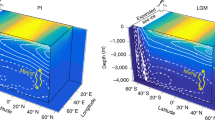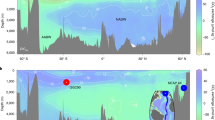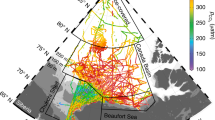Abstract
The Southern Ocean occupies 14% of the Earth’s surface and plays a fundamental role in the global carbon cycle and climate. It provides a direct connection to the deep ocean carbon reservoir through biogeochemical processes that include surface primary productivity, remineralization at depth and the upwelling of carbon-rich water masses. However, the role of these different processes in modulating past and future air–sea carbon flux remains poorly understood. A key period in this regard is the Antarctic Cold Reversal (ACR, 14.6–12.7 kyr bp), when mid- to high-latitude Southern Hemisphere cooling coincided with a sustained plateau in the global deglacial increase in atmospheric CO2. Here we reconstruct high-latitude Southern Ocean surface productivity from marine-derived aerosols captured in a highly resolved horizontal ice core. Our multiproxy reconstruction reveals a sustained signal of enhanced marine productivity across the ACR. Transient climate modelling indicates this period coincided with maximum seasonal variability in sea-ice extent, implying that sea-ice biological feedbacks enhanced CO2 sequestration and created a substantial regional marine carbon sink, which contributed to the plateau in CO2 during the ACR. Our results highlight the role Antarctic sea ice plays in controlling global CO2, and demonstrate the need to incorporate such feedbacks into climate–carbon models.
This is a preview of subscription content, access via your institution
Access options
Access Nature and 54 other Nature Portfolio journals
Get Nature+, our best-value online-access subscription
$29.99 / 30 days
cancel any time
Subscribe to this journal
Receive 12 print issues and online access
$259.00 per year
only $21.58 per issue
Buy this article
- Purchase on Springer Link
- Instant access to full article PDF
Prices may be subject to local taxes which are calculated during checkout






Similar content being viewed by others
Data availability
The data supporting this study is available at National Oceanic and Atmospheric Administration Paleoclimatology Database (https://www.ncdc.noaa.gov/paleo/study/29415). The data from core MD07-3134 are available on the PANGEA Database at https://doi.pangaea.de/10.1594/PANGAEA.819646 and https://doi.pangaea.de/10.1594/PANGAEA.789348. Source data for Figs. 1, 4 and 5 and Extended Data Fig. 1 are available with the paper.
References
Bauska, T. K. et al. Carbon isotopes characterize rapid changes in atmospheric carbon dioxide during the last deglaciation. Proc. Natl Acad. Sci. USA 113, 3465–3470 (2016).
Bauska, T. K. et al. Controls on millennial‐scale atmospheric CO2 variability during the last glacial period. Geophys. Res. Lett. 45, 7731–7740 (2018).
Monnin, E. et al. Atmospheric CO2 concentrations over the Last Glacial Termination. Science 291, 112–114 (2001).
Anderson, R. F. et al. Wind-driven upwelling in the Southern Ocean and the deglacial rise in atmospheric CO2. Science 323, 1443–1448 (2009).
Gottschalk, J. et al. Biological and physical controls in the Southern Ocean on past millennial-scale atmospheric CO2 changes. Nat. Commun. 7, 11539 (2016).
Toggweiler, J. R., Russell, J. L. & Carson, S. R. Midlatitude westerlies, atmospheric CO2, and climate change during the ice ages. Paleoceanography 21, PA2005 (2006).
Marshall, J. & Speer, K. Closure of the meridional overturning circulation through Southern Ocean upwelling. Nat. Geosci. 5, 171–180 (2012).
Huang, H., Gutjahr, M., Eisenhauer, A. & Kuhn, G. No detectable Weddell Sea Antarctic Bottom Water export during the Last and Penultimate Glacial Maximum. Nat. Commun. 11, 14302 (2020).
Jaccard, S. L., Galbraith, E. D., Martínez-García, A. & Anderson, R. F. Covariation of deep Southern Ocean oxygenation and atmospheric CO2 through the last ice age. Nature 530, 207–210 (2016).
Martínez-García, A. et al. Iron fertilization of the Subantarctic ocean during the last ice age. Science 343, 1347–1350 (2014).
Jaccard, S. L. et al. Two modes of change in Southern Ocean productivity over the past million years. Science 339, 1419–1423 (2013).
Butterworth, B. J. & Miller, S. D. Air–sea exchange of carbon dioxide in the Southern Ocean and Antarctic marginal ice zone. Geophys. Res. Lett. 43, 7223–7230 (2016).
Delille, B. et al. Southern Ocean CO2 sink: the contribution of the sea ice. J. Geophys. Res. Oceans 119, 6340–6355 (2014).
Barnes, D.K. Antarctic sea ice losses drive gains in benthic carbon drawdown. Curr. Biol. 25, R789 (2015).
Boyd, P. W., Claustre, H., Levy, M., Siegel, D. A. & Weber, T. Multi-faceted particle pumps drive carbon sequestration in the ocean. Nature 568, 327–335 (2019).
Boyd, P. W. et al. A mesoscale phytoplankton bloom in the polar Southern Ocean stimulated by iron fertilization. Nature 407, 695–702 (2000).
Marcott, S. A. et al. Centennial-scale changes in the global carbon cycle during the last deglaciation. Nature 514, 616–619 (2014).
Fogwill, C. J. & Kubik, P. W. A glacial stage spanning the Antarctic Cold Reversal in Torres del Paine (51°S), Chile, based on preliminary cosmogenic exposure ages. Geogr. Ann. Ser. A 87A, 403–408 (2005).
Pedro, J. B. et al. The spatial extent and dynamics of the Antarctic Cold Reversal. Nat. Geosci. 9, 51–55 (2015).
McGlone, M. S., Turney, C. S. M., Wilmshurst, J. M., Renwick, J. & Pahnke, K. Divergent trends in land and ocean temperature in the Southern Ocean over the past 18,000 years. Nat. Geosci. 3, 622–626 (2010).
Weber, M. E. et al. Millennial-scale variability in Antarctic ice-sheet discharge during the last deglaciation. Nature 510, 134–138 (2014).
Fogwill, C. et al. Antarctic ice sheet discharge driven by atmosphere–ocean feedbacks at the Last Glacial Termination. Sci. Rep. 7, 39979 (2017).
Schmitt, J. et al. Carbon isotope constraints on the deglacial CO2 rise from ice cores. Science 336, 711–714 (2012).
Sprenk, D. et al. Southern Ocean bioproductivity during the last glacial cycle—new decadal-scale insight from the Scotia Sea. Geol. Soc. Spec. Publ. 381, 245–261 (2013).
Meyer-Jacob, C. et al. Independent measurement of biogenic silica in sediments by FTIR spectroscopy and PLS regression. J. Paleolimnol. 52, 245–255 (2014).
Turney, C. S. M. et al. Late Pleistocene and early Holocene change in the Weddell Sea: a new climate record from the Patriot Hills, Ellsworth Mountains, West Antarctica. J. Quat. Sci. 28, 697–704 (2013).
Tetzner, D., Thomas, E. & Allen, C.A. Validation of ERA5 reanalysis data in the Southern Antarctic Peninsula—Ellsworth Land region, and its implications for ice core studies. Geosciences 9, 289 (2019).
Turney, C. S. M. et al. Early Last Interglacial ocean warming drove substantial ice mass loss from Antarctica. Proc. Natl Acad. Sci. USA 117, 3996–4006 (2020).
Winter, K. et al. Assessing the continuity of the blue ice climate record at Patriot Hills, Horseshoe Valley, West Antarctica. Geophys. Res. Lett. 43, 2019–2026 (2016).
Huber, S. A., Balz, A., Abert, M. & Pronk, W. Characterisation of aquatic humic and non-humic matter with size-exclusion chromatography – organic carbon detection – organic nitrogen detection (LC-OCD-OND). Water Res. 45, 879–885 (2011).
Jørgensen, L. et al. Global trends in the fluorescence characteristics and distribution of marine dissolved organic matter. Mar. Chem. 126, 139–148 (2011).
D’Andrilli, J., Foreman, C. M., Sigl, M., Priscu, J. C. & McConnell, J. R. A 21,000 year record of organic matter quality in the WAIS Divide ice core. Clim. Discuss. 2016, 1–15 (2016).
Smith, H. J. et al. Microbial formation of labile organic carbon in Antarctic glacial environments. Nat. Geosci. 10, 356–359 (2017).
Rohde, R. A., Price, P. B., Bay, R. C. & Bramall, N. E. In situ microbial metabolism as a cause of gas anomalies in ice. Proc. Natl Acad. Sci. USA 105, 8667–8672 (2008).
Price, P. & Bay, R. Marine bacteria in deep Arctic and Antarctic ice cores: a proxy for evolution in oceans over 300 million generations. Biogeosciences 9, 3799–3815 (2012).
Moorthi, S., Caron, D., Gast, R. & Sanders, R. Mixotrophy: a widespread and important ecological strategy for planktonic and sea-ice nanoflagellates in the Ross Sea, Antarctica. Aquat. Micro. Ecol. 54, 269–277 (2009).
Massana, R. Eukaryotic picoplankton in surface oceans. Annu. Rev. Microbiol. 65, 91–110 (2011).
Rodionov, S.N. A sequential algorithm for testing climate regime shifts. Geophys. Res. Lett. 31, L09204 (2004).
Wolff, E. W. et al. Southern Ocean sea-ice extent, productivity and iron flux over the past eight glacial cycles. Nature 440, 491–496 (2006).
Abelmann, A. et al. The seasonal sea-ice zone in the glacial Southern Ocean as a carbon sink. Nat. Commun. 6, 8136 (2015).
Esper, O. & Gersonde, R. New tools for the reconstruction of Pleistocene Antarctic sea ice. Palaeogeogr. Palaeoclimatol. Palaeoecol. 399, 260–283 (2014).
Menviel, L., Timmermann, A., Elison Timm, O. & Mouchet, A. Deconstructing the Last Glacial Termination: the role of millennial and orbital-scale forcings. Quat. Sci. Rev. 30, 1155–1172 (2011).
Collins, L. G., Pike, J., Allen, C. S. & Hodgson, D. A. High-resolution reconstruction of southwest Atlantic sea-ice and its role in the carbon cycle during marine isotope stages 3 and 2. Paleoceanography 27, PA3217 (2012).
Duprat, L. P. A. M., Bigg, G. R. & Wilton, D. J. Enhanced Southern Ocean marine productivity due to fertilization by giant icebergs. Nat. Geosci. 9, 219–221 (2016).
Fogwill, C. J., Phipps, S. J., Turney, C. S. M. & Golledge, N. R. Sensitivity of the Southern Ocean to enhanced regional Antarctic ice sheet meltwater input. Earth Future 3, 317–329 (2015).
Golledge, N. R. et al. Antarctic contribution to meltwater pulse 1A from reduced Southern Ocean overturning. Nat. Commun. 5, 6107 (2014).
Menviel, L., Timmermann, A., Timm, O. E. & Mouchet, A. Climate and biogeochemical response to a rapid melting of the West Antarctic Ice Sheet during interglacials and implications for future climate. Paleoceanography 25, PA4231 (2010).
Hogg, A. Punctuated shutdown of Atlantic Meridional Overturning Circulation during the Greenland Stadial 1. Sci. Rep. 6, 25902 (2016).
Menviel, L. et al. Southern Hemisphere westerlies as a driver of the early deglacial atmospheric CO2 rise. Nat. Commun. 9, 2503 (2018).
Parkinson, C. L. A 40-y record reveals gradual Antarctic sea ice increases followed by decreases at rates far exceeding the rates seen in the Arctic. Proc. Natl Acad. Sci. USA 116, 14414–14423 (2019).
WAIS Divide Members Precise interpolar phasing of abrupt climate change during the last ice age. Nature 520, 661–665 (2015).
Wolff, E. et al. Southern Ocean sea-ice extent, productivity and iron flux over the past eight glacial cycles. Nature 440, 491–496 (2006).
Orsi, A. H., Whitworth, T. III & Nowlin, W. D. Jr. On the meridional extent and fronts of the Antarctic Circumpolar Current. Deep Sea Res. Pt 1 42, 641–673 (1995).
Stein, A. et al. NOAA’s HYSPLIT atmospheric transport and dispersion modeling system. Bull. Am. Meteorol. Soc. 96, 2059–2077 (2015).
Wessel, P. et al. New, improved version of Generic Mapping Tools released. Eos 79, 579–579 (1998).
Iannone, R. Splitr: Use the HYSPLIT model from inside R. R package version 0.4.0.9000 https://www.rdocumentation.org/packages/SplitR/versions/0.4 (2019).
Carslaw, D. C. & Ropkins, K. Openair—an R package for air quality data analysis. Environ. Model. Softw. 27–28, 52–61 (2012).
Reijmer, C. H., Greuell, W. & Oerlemans, J. The annual cycle of meteorological variables and the surface energy balance on Berkner Island, Antarctica. Ann. Glaciol. 29, 49–54 (1999).
Abram, N. J., Mulvaney, R., Wolff, E. W. & Mudelsee, M. Ice core records as sea ice proxies: an evaluation from the Weddell Sea region of Antarctica. J. Geophys. Res. 112, D15101 (2007).
Fox, B., Thorn, R., Anesio, A. & Reynolds, D. M. The in situ bacterial production of fluorescent organic matter; an investigation at a species level. Water Res. 125, 350–359 (2017).
Tuner, C. R., Miller, D. J., Coyne, K. J. & Corush, J. Improved methods for capture, extraction, and quantitative assay of environmental DNA from Asian bigheaded carp (Hypophthalmichthys spp.). PLoS ONE 9, e114329 (2014).
Adler, C. J. et al. Sequencing ancient calcified dental plaque shows changes in oral microbiota with dietary shifts of the Neolithic and Industrial revolutions. Nat. Genet. 45, 450–455 (2013).
Caporaso, J. G. Ultra-high-throughput microbial community analysis on the Illumina HiSeq and MiSeq platforms. ISME J. 6, 1621–1624 (2012).
Caporaso, J. G. QIIME allows analysis of high-throughput community sequencing data. Nat. Methods 7, 335–336 (2010).
DeSantis, T. Z. et al. Greengenes, a chimera-checked 16S rRNA gene database and workbench compatible with ARB. Appl. Environ. Microbiol. 72, 5069–5072 (2006).
Salter, S. J. et al. Reagent and laboratory contamination can critically impact sequence-based microbiome analyses. BMC Biol. 12, 87 (2014).
Chen, T. et al. The Human Oral Microbiome Database: a web accessible resource for investigating oral microbe taxonomic and genomic information. Database 2010, baq013 (2010).
Sunagawa, S. et al. Structure and function of the global ocean microbiome. Science 348, 1261359 (2015).
Acknowledgements
C.J.F., C.S.M.T., L.M., N.R.G., L.S.W. and A.C. are supported by their respective Australian Research Council (ARC) and Royal Society of NZ fellowships, and C.J.F. and A.G.C. thank Keele University for a Research Development Award that underpinned this research at Keele University IceLab and Exeter University. Fieldwork was undertaken under ARC Linkage Project (LP120200724), supported by Linkage Partner Antarctic Logistics and Expeditions, whose enduring support we acknowledge. CSIRO’s contribution was supported in part by the Australian Climate Change Science Program (ACCSP), an Australian Government Initiative. S.D. acknowledges financial support from Coleg Cymraeg Cenedlaethol and the European Research Council (ERC grant agreement no. 25923). M.E.W. acknowledges support from the Deutsche Forschungsgemeinschaft (grant no. We2039/8-1). Finally, we thank H. Glanville for comments on the final draft of the manuscript, and A. Jeffery for advice on SEM analysis.
Author information
Authors and Affiliations
Contributions
C.J.F., C.S.M.T., A.B. and A.C. conceived this research. C.J.F., C.S.M.T., A.B., M.E.W., D.E., M.R., D.P.T., T.D.vO., A.D.M., M.A.J.C., S.D., M.I.B., N.C.M., J.V., A.R., L.M., H.M., CM, J.Y., M.M., A.G.C., M.R.P.H., A.P., J.L. and L.S.W. undertook analysis and sampling. C.J.F., C.S.M.T., A.B., M.E.W., M.R.P.H. and A.C. wrote the manuscript with input from all the authors.
Corresponding author
Ethics declarations
Competing interests
The authors declare no competing interests.
Additional information
Peer review information Primary Handling Editor: James Super.
Publisher’s note Springer Nature remains neutral with regard to jurisdictional claims in published maps and institutional affiliations.
Extended data
Extended Data Fig. 1 Reproducibility of fOM signal.
Reproducibility of fOM signal. 5 m resolved fOM concentration (Component 1; TRYLIS in red), plotted against data from a second parallel transect from the Patriot Hills transect (~3 m resolved black dashed line). The dashed lines represent replicate samples from the same transect which were taken in 2014/15 and measured in 2015 at UNSW Icelab (black dots), and subsequently reanalysed in 2019 at Keele Icelab (red triangles). The records are synchronised from water stable isotopes, site survey data and DGPS, and taken within 4 m of one another from a parallel transect (inset).
Supplementary information
Supplementary Information
Supplementary Sections 1–9, Figs. 1–7 and Tables 1–3.
Source data
Source Data Fig. 1
Numerical data used to generate graphs in the figure.
Source Data Fig. 4
Numerical data used to generate graphs in the figure.
Source Data Fig. 5
Numerical data used to generate graphs in the figure.
Source Data Extended Data Fig. 1
Numerical data used to generate graphs in the figure.
Rights and permissions
About this article
Cite this article
Fogwill, C.J., Turney, C.S.M., Menviel, L. et al. Southern Ocean carbon sink enhanced by sea-ice feedbacks at the Antarctic Cold Reversal. Nat. Geosci. 13, 489–497 (2020). https://doi.org/10.1038/s41561-020-0587-0
Received:
Accepted:
Published:
Issue Date:
DOI: https://doi.org/10.1038/s41561-020-0587-0
This article is cited by
-
Ancient marine sediment DNA reveals diatom transition in Antarctica
Nature Communications (2022)
-
Southern Ocean contribution to both steps in deglacial atmospheric CO2 rise
Scientific Reports (2021)
-
Antarctic ice dynamics amplified by Northern Hemisphere sea-level forcing
Nature (2020)
-
A coherent response of Southern Indian Ocean to the Antarctic climate: Implications to the lead, lags of atmospheric CO2 during deglaciation
Journal of Earth System Science (2020)



